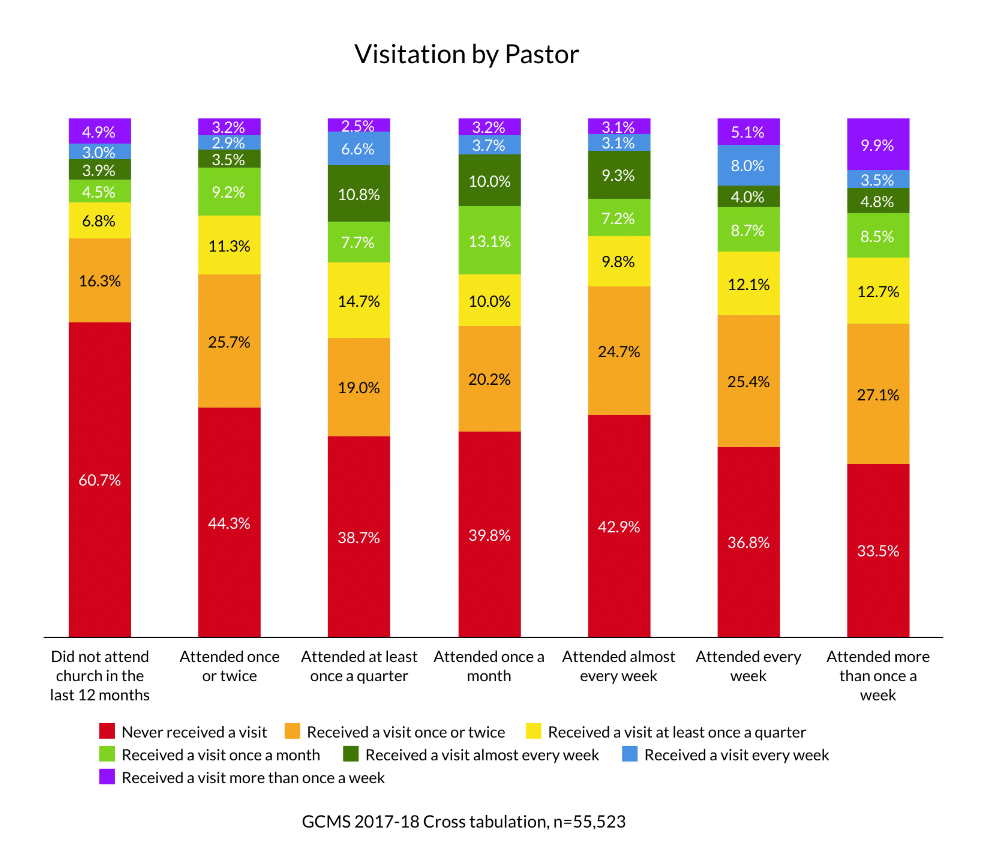And they continued steadfastly in the apostles’ doctrine and fellowship, and in breaking of bread, and in prayers. And fear came upon every soul: and many wonders and signs were done by the apostles. And all that believed were together, and had all things common…
Acts 2:42–47, KJV
And they, continuing daily with one accord in the temple, and breaking bread from house to house, did eat their meat with gladness and singleness of heart, praising God, and having favour with all the people. And the Lord added to the church daily such as should be saved.
In our last blog, we examined how effectively the Adventist Church uses Christ’s method to minister to those outside the Church. However, how good are we, as a church, at ministering to our own members?
The Global Church Member Survey 2017-18 (GCMS) asked members how often, in the last 12 months, they had received a visit from their pastor. The largest group of respondents (38%) reported that they had never received such a visit. Another quarter (25%) reported one or two pastoral visits in the last year. Twelve percent reported such a visit every quarter, and another 25% had received pastor’s visits once a month or more often.

When the survey results were cross-tabulated, they showed that members who did not attend church in the last 12 months were least likely to receive pastoral visits. Members who attended church every week were most likely to receive frequent (i.e., weekly) visits from their pastor. These findings point to a lack of tender pastoral care of non-regular churchgoers.

Church members were also asked how often in the last year they had received a visit from a church elder. The results were similar to the visits by a pastor. Two out of five (41%) respondents had never received a visit from an elder, while 23% reported an elder’s visiting once or twice in the last year. Ten percent reported that an elder had visited their home approximately once a quarter, and again, 25% had enjoyed visits from a church elder once a month or more often.

When the results were cross-tabulated, they revealed similar results to the frequency of pastoral visits. Those who did not attend church in the last 12 months were least likely to receive a visit from an elder, while members who attended church every week were most likely to receive such visits, specifically on a weekly basis.

These numbers are concerning as they reveal that church leadership does not appear to be reaching out to those who have stepped away from the church or are not regular attenders/regularly involved. However, it is vital that church leadership connect with all of their members, especially those who are no longer active. After all, “they that are whole have no need of the physician, but they that are sick: I came not to call the righteous, but sinners to repentance” (Mark 2:17, KJV).
How do members do when it comes to interacting with each other? Are they doing better about visiting each other, with more frequent visits than pastors and/or elders? The number of those who had not received a visit from a fellow church member in the last year was almost twice as low as those never having been visited by an elder (21%). Another quarter (26%) reported having received one or two such visits once or twice a year, and 13% had received a visit from a church member at least once a quarter in the last year. A large number (40%) had also received such visits once a month or more often.

When we examine the structure of the young Christian church in the New Testament, as well as review the letters written by the apostles Peter, Paul, and John, we see over and over again how important it is to be in Christian community with each other. We also see that there is great spiritual power when believers come together in the name of Christ.
Members who did not attend church in the last 12 months were again the least-visited category of members when the numbers were cross-tabulated. It appears that church members were also keen to engage in community with each other, perhaps neglecting those who have fallen by the wayside or were outside the church’s four walls. It might also be that local churches do not have information about those who have stopped attending church services in the last year.

Based on the results of the 2017-2018 GCMS, local church leadership should be challenged to be aware of what is happening in the lives of their members and visit them more frequently; similarly, church members should be challenged to visit and fellowship with each other more often. While this may seem difficult to do during a global pandemic, it may be time to consider more creative ways of interacting. Scheduling a Zoom hangout, small group meeting, or FaceTime call; getting together for a physically distanced picnic or chat; or even sending a handwritten note can all be great ways to remind members that they are valued. In addition, such interactions may now have strong results in bringing members back inside the four walls of the church when the pandemic has passed.
“A new commandment I give unto you, that ye love one another; as I have loved you, that ye also love one another. By this shall all men know that ye are my disciples, if ye have love one to another” (John 13:34-35, KJV).
For more information on 2017-18 Global Church Member Survey (GCMS) go to the Meta-Analysis Report.
Creado en colaboración con el Instituto del Ministerio de la Iglesia (Institute of Church Ministry).
Published by ASTR

